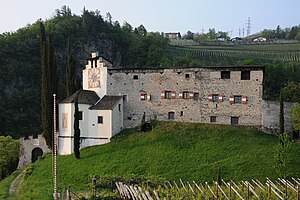Braunsberg Castle
| Braunsberg Castle | ||
|---|---|---|
| Creation time : | 13th Century | |
| Castle type : | Hilltop castle | |
| Place: | Lana | |
| Geographical location | 46 ° 36 '54.2 " N , 11 ° 8' 21.3" E | |
|
|
||
Braunsberg Castle is a high-altitude castle on the edge of the Gaul Gorge and the landmark of the market town of Lana in South Tyrol .
history
As early as 1082 a Bertholdus de Leunon et Brůnsberc appears in the documents of the Weingarten monastery ; however, the record has been proven to be a diplomatic forgery of the late 13th century and can therefore not be considered a first mention. It can be assumed that the castle complex was only built in the 13th century by the Lords of Braunsberg as ministerials to the Counts of Tyrol ; this family of servants owned the property for over 200 years. Like the Brandis , the Lebenberg and the Werrenberg (on the Werrenberg, also called the Tower of Völlan ), they were descendants of the Lords of Lana .
Around 1300 Isolde von Braunsberg ( domina Ysalda de Prounsperg ) appears in the documents; she was the wife of Hugos I von Niedertor and married Konrad Maiser after his early death. In 1361 the family died out with Paul von Braunsberg and, after the death of his widow, fell to Randolf von Brandis and Etzlin von Andrian in equal parts. In 1401, Duke Leopold IV of Habsburg gave the entire castle as a fief to Hans Mareyder. Since then, the sex has been called Mareyder von Braunsberg . After the family died out in the middle of the 15th century, Braunsberg was drafted by the sovereign. On February 9, 1492, Emperor Maximilian I gave the castle and the Ulten rulership for 15,000 florins to the brothers Jakob V and Jörg Trapp as a fief. In 1510 part of the castle complex including the tower is said to have crashed into the Gaul Gorge. In 1925 the castle was repaired by Gottfried Graf Trapp. In 1969 Braunsberg came to Oswald Graf Strachwitz via inheritance and in 1997 to his son Rupert Graf Strachwitz.
investment
Presumably, the defensive wall built on the mountain side and provided with battlements once surrounded the entire complex. There are walled dovetail pinnacles on the residential building. The front wall of the chapel is frescoed with the coats of arms of Austria, Tyrol and the Counts of Trapp . The originally Romanesque chapel is dedicated to St. Blasius and was enlarged around 1670 by adding a choir. In the interior of the chapel there is a wooden altar from around 1660 with an image of St. Blaise. The chairs are adorned with metal eagles and the Trapps' coats of arms. The furnishings include valuable relics such as a silver chalice from the 13th century.
legend
According to a legend, in 1393 the lady of the castle Jutta rushed from the castle into the Gaulschlucht, as she was falsely accused of infidelity towards her husband (who had moved to Palestine). A votive picture from 1748 that hangs in the chapel testifies to the event.
literature
- Oswald Trapp : Tiroler Burgenbuch. Volume II: Burgrave Office . Athesia publishing house, Bozen 1980, pp. 243-250.
Web links
- Entry in the monument browser on the website of the South Tyrolean Monuments Office
- braunsberg.org
- Braunsberg Castle on meranerland.org
Individual evidence
- ^ Franz Huter : Tyrolean document book . I. Abt. Volume 1. Innsbruck: Wagner 1937. pp. 50–51, no. 101 (also on older literature).
- ^ Hannes Obermair : Bozen Süd - Bolzano Nord. Written form and documentary tradition of the city of Bozen up to 1500 . tape 1 . City of Bozen, Bozen 2005, ISBN 88-901870-0-X , p. 154, no.190 .
- ^ Johann Nepomuk von Alpenburg , Knight of Alpenburg Mahl-Schedl: Deutsche Alpensagen . Braumüller, 1861 ( google.de [accessed October 14, 2017]).
- ↑ Berit Mrugalska, Wolfgang Morscher: Most Say from South Tyrol . Haymon Verlag, 2012, ISBN 978-3-7099-7488-9 ( google.de [accessed October 14, 2017]).


